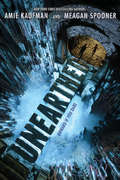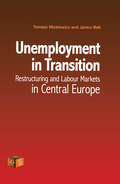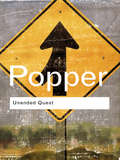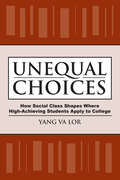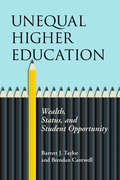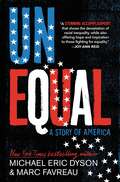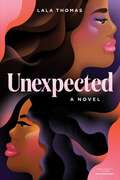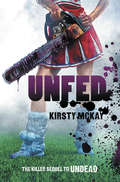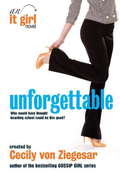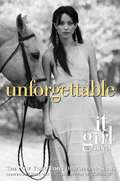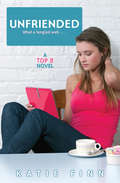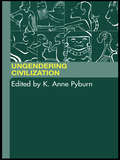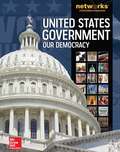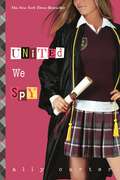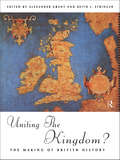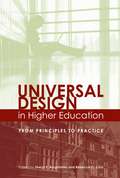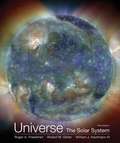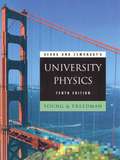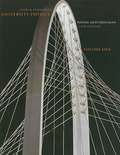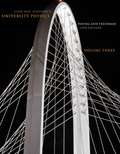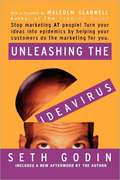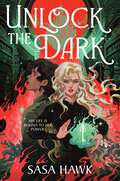- Table View
- List View
Unearthed (Unearthed #1)
by Amie Kaufman Meagan SpoonerFrom the New York Times best-selling author duo Amie Kaufman and Meagan Spooner comes a "literally breathtaking" new sci-fi series about a death-defying mission on an alien planet. When Earth intercepts a message from a long-extinct alien race, it seems like the solution humanity has been waiting for. The Undying's advanced technology has the potential to undo environmental damage and turn lives around, and their message leads to the planet Gaia, a treasure trove waiting to be explored.For Jules Addison and his fellow scholars, the discovery of an ancient alien culture offers unprecedented opportunity for study... as long as scavengers like Amelia Radcliffe don't loot everything first. Despite their opposing reasons for smuggling themselves onto the alien planet's surface, they're both desperate to uncover the riches hidden in the Undying temples. Beset by rival scavenger gangs, Jules and Mia form a fragile alliance... but both are keeping secrets that make trust nearly impossible.As they race to decode the ancient messages, Jules and Mia must navigate the traps and trials within the Undying temples and stay one step ahead of the scavvers on their heels. They came to Gaia certain that they had far more to fear from their fellow humans than the ancient beings whose mysteries they're trying to unravel. But the more they learn about the Undying, the more Jules and Mia start to feel like their presence in the temple is part of a grand design--one that could spell the end of the human race...
Unemployment in Europe: Problems and Policies
by Valerie SymesUnemployment is the most serious economic and social problem in Europe today. Although the extent varies from region to region, it is generally most extreme in large cities. This volume asks why European unemployment is so high and examines the policies adopted at local, national and European level to tackle the problems. It also includes five case
Unemployment in Transition: Restructuring and Labour Markets in Central Europe (Economies in Transition to the Market #Vol. 1)
by Tomasz Mickiewicz Janice BellThe emergence of open unemployment is an unavoidable consequence of postcommunist transition. Some countries-notably in the former Soviet Union-initially slowed economic contraction. But in the longer run slower reformers have generally sustained deeper and more prolonged recessions than faster reforming central European countries. Moreover, the initially low unemployment rates in the former Soviet Union are now rising, and may stabilise at higher post-transition equilibrium rates than in Central Europe.
Unended Quest: An Intellectual Autobiography (Routledge Classics)
by Karl PopperAt the age of eight, Karl Popper was puzzling over the idea of infinity and by fifteen was beginning to take a keen interest in his father's well-stocked library of books. Unended Quest recounts these moments and many others in the life of one of the most influential thinkers of the twentieth century, providing an indispensable account of the ideas that influenced him most. As an introduction to Popper's philosophy, Unended Quest also shines. Popper lucidly explains the central ideas in his work, making this book ideal for anyone coming to Popper's life and work for the first time.
Unequal Choices: How Social Class Shapes Where High-Achieving Students Apply to College (The American Campus)
by Yang Va LorHigh-achieving students from socioeconomically disadvantaged backgrounds are more likely to end up at less selective institutions compared to their socioeconomically advantaged peers with similar academic qualifications. A key reason for this is that few highly able, socioeconomically disadvantaged students apply to selective institutions in the first place. In Unequal Choices, Yang Va Lor examines the college application choices of high-achieving students, looking closely at the ways the larger contexts of family, school, and community influence their decisions. For students today, contexts like high schools and college preparation programs shape the type of colleges that they deem appropriate, while family upbringing and personal experiences influence how far from home students imagine they can apply to college. Additionally, several mechanisms reinforce the reproduction of social inequality, showing how institutions and families of the middle and upper-middle class work to procure advantages by cultivating dispositions among their children for specific types of higher education opportunities.
Unequal Higher Education: Wealth, Status, and Student Opportunity (The American Campus)
by Brendan Cantwell Barrett J. TaylorAmerican higher education is often understood as a vehicle for social advancement. However, the institutions at which students enroll differ widely from one another. Some enjoy tremendous endowment savings and/or collect resources via research, which then offsets the funds that students contribute. Other institutions rely heavily on student tuition payments. These schools may struggle to remain solvent, and their students often bear the lion’s share of educational costs. Unequal Higher Education identifies and explains the sources of stratification that differentiate colleges and universities in the United States. Barrett J. Taylor and Brendan Cantwell use quantitative analysis to map the contours of this system. They then explain the mechanisms that sustain it and illustrate the ways in which rising institutional inequality has limited individual opportunity, especially for students of color and low-income individuals.
Unequal: A Story of America
by Marc Favreau Michael Eric DysonFinalist for the YALSA Excellence in Nonfiction for Young Adults Award New York Times bestselling author Michael Eric Dyson and critically acclaimed author Marc Favreau show how racial inequality permeates every facet of American society, through the lens of those pushing for meaningful change The true story of racial inequality—and resistance to it—is the prologue to our present. You can see it in where we live, where we go to school, where we work, in our laws, and in our leadership. Unequal presents a gripping account of the struggles that shaped America and the insidiousness of racism, and demonstrates how inequality persists. As readers meet some of the many African American people who dared to fight for a more equal future, they will also discover a framework for addressing racial injustice in their own lives.
Unexpected: A Novel
by LaLa ThomasThe bond between two best friends is put to the test when one of them gets pregnant in this &“powerful and timely&” (award-winning author Angela Johnson) contemporary young adult novel for fans of Angie Thomas and Elizabeth Acevedo.Erykah was looking forward to junior year at East Prep High. She has a cute boyfriend, gets good grades, and has the best bestie. Money is tight, though that&’s nothing new in her world. But everything changes when she gets pregnant. Having a baby at sixteen was definitely not part of the plan. Kelly&’s plan was to dominate junior year—grade-wise and on the basketball court—and eventually get an athletic scholarship. It did not include helping her best friend through a pregnancy. But that&’s what best friends do, right? Besides, Kelly has every intention of being a good auntie. As the two girls navigate the pregnancy, they&’ll learn some harsh realities about the world and be forced to make some huge decisions. They&’ll also discover a deep reserve of strength and compassion…for each other and themselves.
Unfed (Undead Ser. #2)
by Kirsty McKayFresh meat! From a hospital of horrors to a runaway zombie train, it's an all-new onslaught of the slavering undead in the sequel to Kirsty McKay's killer debut!Just when you think you're out...it's the morning after the night of the return of the living dead. Or something like that. After running/bus-driving/snowboarding for her life alongside rebel Smitty, geeky Pete, and popular Alice, Bobby thought she'd found the antidote to the Carrot Man Veggie Juice that had turned the rest of their classmates into zombies. When Smitty (mmm...nom, nom) got chomped, Bobby pumped a syringe full of it into him herself.But now Bobby's a prisoner in some hospital of horrors, with no clue how she got there. And Smitty is missing. What if he isn't cured after all? Bobby knows she's got to find him, even if it means facing Scotland's hungry hordes -- plus Alice's buckets of snark -- again. And this time, zombies aren't the only evil stressing her out. The brain-dead are bad enough, but how can Bobby stop the big pharma business behind the epidemic? Especially when her own mom works for the company?
Unforgettable: An It Girl Novel
by Cecily Von ZiegesarSince Jenny arrived at Waverly Academy and set out on her mission to become it, she's certainly made an impact! From stealing her roommate's boyfriend to making an enemy of the notorious Tinsley Carmichael, she's always given the girls something to talk about. But old rivalries are about to make way for new friendships as Dumbarton's residents embrace the sharing-is-caring vibe at the newly founded Women of Waverly club. There are some pretty juicy topics up for discussion and even juicier topics being kept under wraps. For now...
Unforgettable: An It Girl Novel (It Girl Novel #4)
by Cecily Von ZiegesarHaving a roommate at elite Waverly Academy means nightly sleepovers and double the designer wardrobe. But Callie Vernon never really liked late-night girl talk or swapping cashmere sweaters with her younger, rosy-cheeked roomie, Jenny Humphrey. So when Jenny stole her longtime boyfriend, Easy Walsh, Callie didn't feel that guilty about turning right around and kissing him behind Jenny's back. Okay, maybe a little guilty, but it certainly didn't stop her from enjoying it. Now, if only Easy would stop being so irritatingly indecisive and dump Jenny already! While the two roommates are sharing a boyfriend, the rest of Dumbarton's residents are sharing their feelings at the newly founded Women of Waverly club--aka, WOW! Everyone is totally bonding, revealing their most personal secrets, and hugging out their past rivalries. But despite the sharing-is-caring vibe, there are some things these girls aren't spilling--like who's making special late-night trips to the crater . . . and with whom.Now it's only a matter of time before all the newfound girl power explodes into a massive girl fight. But this battle goes well beyond the ivy colored brick walls of Dumberton--it's about who will be Waverly's next It Girl.
Unfriended: Unfriended (Top 8 Ser. #3)
by Katie FinnMadison MacDonald is glad things are back to normal!Madison It’s SUMMER at last -- let the good times & pool parties roll!Location: Putnam Beach. Putnam, CT.Madison My friends are all together again, and Nate and I are better than ever. Finally, everything in my life is working out. :)Location: Gofer Ice Cream. Putnam, CTMadison Even though Nate will be leaving for college in the fall.Location: New Canaan Drive-In. New Canaan, CT. Madison And there’s a piece of me that’s still waiting for the other shoe to drop from the prom heist.Location: Stubbs Coffee. Putnam, CT.Madison But everything is going to be fine! Right?Location: On A Blender Smoothie Shop. Putnam, CT.Madison Oh. Maybe I should take that back --Location: UndisclosedTHIS ACCOUNT HAS BEEN TEMPORARILY DISABLED.Madison MacDonald thinks the other shoe just dropped.
Ungendering Civilization
by K. Anne PyburnWith nine papers examining a distinct body of archaeological data, Ungendering Civilization offers a much needed scrutiny of the role of women in the evolution of states. Studying societies including Predynastic Egypt, Minoan Crete, ancient Zimbabwe and the Maya - to determine what the facts actually show, the contributors critically address traditional views of male and female roles, and argue for the possibility that the root historical cause of gender subordination is participation in modern world system, rather than 'innate' tendencies to domesticity and child-rearing in women, and leadership and aggression in men. With an interdisciplinary potential, students of archaeology, cultural studies and gender studies will find this full of useful information.
United States Government Our Democracy
by Donald A. Ritchie Richard C. RemyUnited States government textbook
United We Spy (Gallagher Girls #6)
by Ally CarterDon't miss a moment of the beloved New York Times bestselling series where spies-in-training navigate double crosses, secret missions, friendship, and first love--now with a bonus epilogue! Cammie Morgan has lost her father and her memory, but in the heart-pounding conclusion to the best-selling Gallagher Girls series, she finds her greatest mission yet. Cammie and her friends finally know why the terrorist organization called the Circle of Cavan has been hunting her. Now the spy girls and Zach must track down the Circle's elite members to stop them before they implement a master plan that will change Cammie-and her country-forever. Get ready for the Gallagher Girls' most astounding adventure yet as the series comes to breathtaking conclusion that will have readers racing to the last page.
Uniting the Kingdom?: The Making of British History
by Alexander Grant Keith J. StringerIn Uniting the Kingdom? a group of the most distinguished historians from Britain and Ireland assemble to consider the question of British identity spanning the period from the Middle Ages to the present. Traditional chronological and regional frontiers are broken down as medievalists, early modernists and modernists debate the key issues of the British state: the conflicting historiographies, the nature of political tensions and the themes of expansion and contraction. This outstanding collection of essays forms an illuminating introduction to the most up-to-date thinking about the problems of British histories and identities.
Universal Design in Higher Education: From Principles to Practice
by Sheryl Burgstahler Rebecca CoryUniversal design (UD) has a rich history in applications to commercial products and architecture and is now being applied to instruction and student services. UD holds promise for making educational products and environments more inclusive of all students, faculty, staff, and visitors. This chapter is an overview of topics covered in this book, including the definition and principles of UD, the process of UD, and applications of UD in higher education (UDHE).
Universe: The Solar System (Fifth Edition)
by Roger FreedmanThis is an abbreviated volume of Universe, focusing on the Solar System. The various Universe books place the basics of astronomy and the process of science within the grasp of introductory students. The 5th edition has been updated with new material and new discoveries.
University Physics
by Wolfgang Bauer Gary D. WestfallUniversity Physics is intended for use in the calculus-based introductory physics sequence at universities and colleges. It can be used in either a two-semester introductory sequence or a three-semester sequence. The course is intended for students majoring in the biological sciences, the physical sciences, mathematics, and engineering.
University Physics (Tenth Edition)
by Young Roger A. Freedman T. R. Sandin A. Lewis FordNow in its commemorative Tenth Edition, this book remains a classic. Adhering to the highest standards of integrity and incorporating some of the findings of current research in physics, it enables readers to develop physical intuition and build strong problem-solving skills. It also points out conceptual and computational pitfalls that commonly plague beginning physics students and provides them with explicit strategies for analyzing physical situations and solving problems.
University Physics (Volume 1) (13th Edition)
by Roger A. Freedman Hugh D. YoungUniversity Physics with Modern Physics, continues to set the benchmark for clarity and rigor combined with effective teaching and research-based innovation. University Physics is known for its uniquely broad, deep, and thoughtful set of worked examples--key tools for developing both physical understanding and problem-solving skills. The Thirteenth Edition revises all the Examples and Problem-Solving Strategies to be more concise and direct while maintaining the Twelfth Edition's consistent, structured approach and strong focus on modeling as well as math. To help students tackle challenging as well as routine problems, the Thirteenth Edition adds Bridging Problems to each chapter, which pose a difficult, multiconcept problem and provide a skeleton solution guide in the form of questions and hints. The text's rich problem sets--developed and refined over six decades--are upgraded to include larger numbers of problems that are biomedically oriented or require calculus. The problem-set revision is driven by detailed student-performance data gathered nationally through MasteringPhysics®, making it possible to fine-tune the reliability, effectiveness, and difficulty of individual problems. Complementing the clear and accessible text, the figures use a simple graphic style that focuses on the physics. They also incorporate explanatory annotations--a technique demonstrated to enhance learning. The above ISBN is just for the standalone book only Chapters 1-20, if you want the Book(only Chapters 1-20/Access Code please order: ISBN: 0321785916 / 9780321785916 University Physics Volume 1(Chapters 1-20 only ) and MasteringPhysics® with Pearson eText Student Access Code Card Package consists of: 032173338X / 9780321733382 University Physics Volume 1 (Chs. 1-20 only) 0321741269 / 9780321741264 MasteringPhysics® with Pearson eText Student Access Code Card for University Physics If you want the complete book order ISBN 0321696867 9780321696861 University Physics with Modern Physics, 13/e -- or valuepack 0321675460 / 9780321675460 University Physics with Modern Physics with MasteringPhysics® Package consists of 0321696867 / 9780321696861 University Physics with Modern Physics(complete book) 0321741269 / 9780321741264 MasteringPhysics® with Pearson eText Student Access Code Card for University Physics (ME component )
University Physics: Technology Update, Volume 2
by Roger A. Freedman A. Lewis Ford Hugh D. YoungUniversity Physics with Modern Physics, Technology Update, Thirteenth Edition continues to set the benchmark for clarity and rigor combined with effective teaching and research-based innovation. Volume 2 is Chapters 21 to 37.
University Physics: Volume 3
by Roger A. Freedman A. Lewis Ford Hugh D. YoungUniversity Physics Volume 3 (Chapters 37-44 only), 13/e continues to set the benchmark for clarity and rigor combined with effective teaching and research-based innovation. University Physics is known for its uniquely broad, deep, and thoughtful set of worked examples--key tools for developing both physical understanding and problem-solving skills. The Thirteenth Edition revises all the Examples and Problem-Solving Strategies to be more concise and direct while maintaining the Twelfth Edition's consistent, structured approach and strong focus on modeling as well as math. To help students tackle challenging as well as routine problems, the Thirteenth Edition adds Bridging Problems to each chapter, which pose a difficult, multiconcept problem and provide a skeleton solution guide in the form of questions and hints. The text's rich problem sets--developed and refined over six decades--are upgraded to include larger numbers of problems that are biomedically oriented or require calculus.
Unleashing the Ideavirus: Stop Marketing AT People! Turn Your Ideas into Epidemics by Helping Your Customers Do the Marketing Thing for You.
by Malcolm Gladwell Seth GodinThe book that sparked a marketing revolution."This is a subversive book. It says that the marketer is not--and ought not to be--at the center of successful marketing. The customer should be. Are you ready for that?" --From the Foreword by Malcolm Gladwell, author of The Tipping Point.Counter to traditional marketing wisdom, which tries to count, measure, and manipulate the spread of information, Seth Godin argues that the information can spread most effectively from customer to customer, rather than from business to customer. Godin calls this powerful customer-to- customer dialogue the ideavirus, and cheerfully eggs marketers on to create an environment where their ideas can replicate and spread.In lively detail, Godin looks at the ways companies such as PayPal, Hotmail, GeoCities, even Volkswagen have successfully launched ideaviruses. He offers a "recipe" for creating your own ideavirus, identifies the key factors in the successful spread of an ideavirus (powerful sneezers, hives, a clear vector, a smooth, friction-free transmission), and shows how any business, large or small, can use ideavirus marketing to succeed in a world that just doesn't want to hear it anymore from the traditional marketers.
Unlock the Dark
by Sasa HawkPerfect for fans of Brigid Kemmerer and Lexi Ryan, this debut romantasy stand-alone novel blends an immersive world, unique magic system, and swoon-worthy romance to create an unputdownable read that explores the great and terrible lengths to which love compels us to go.Elia Tallis’s key conjuring abilities, when used with her father’s magic, allow her to open a path to any location. But Papa is dying, and Elia has been forced to painfully tether him to life so she can siphon his magic to provide for her siblings. The god of death, angry to be denied his due, punishes her by claiming her youngest brother as a servant.Desperate to save her brother, Elia accepts a potentially deadly commission from Trys, a kindhearted prince with his nose stuck in a book. Trys wants Elia to help him find a legendary scroll. In exchange, he’ll give her his hand in marriage, securing her and her siblings’ futures and allowing her to release Papa to the afterlife.Despite the danger of their quest, Elia and Trys find themselves increasingly drawn to each other. But when Trys finally reads the scroll, it transforms him into a monster beyond comprehension. Elia will have to wield her power in ways she never thought possible, braving a world of endless darkness and the nightmares dwelling within it to bring home the prince she’s growing to love.
